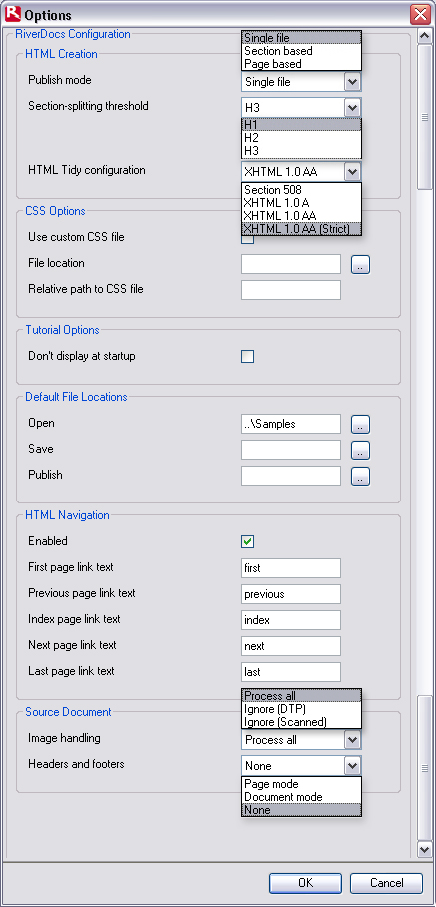Detailed User Instructions
Important: Before starting conversion of a file, you should choose conversion settings and decide which of the available HTML publish mode settings you want to apply.
RiverDocs provides configuration options for the source document that affect the conversion process, and publishing options that affect the output. You access these configuration options by clicking the Options button in the Main toolbar or pressing Alt+F11.
Settings are made in the Options dialog box, as follows:
Setting HTML publishing options
HTML Creation
This section allows you to make write mode settings.
Publish mode
The Publish mode drop-down list box has three options, Single file, Section based and Page based, which take effect during automatic conversion. In the example, Single file is being selected. With this option, the Converter generates a single web page from the source document. Section-based publishes the document with a web page for each section.
Section-splitting threshold
You can select a section-splitting threshold if you are using Section-based publication. This allows you to set at which heading level separate HTML pages will be created. Note that the splitting is based on the heading format information in the original document, as displayed in the TOC pane, so headings inserted in the HTML after conversion will not produce additional splits. You can edit the text of the TOC headings, but not insert new ones.
Even if you opt to convert to a single HTML file (Single file), you will still be able to view the document's page divisions in the Converter's Editing pane after conversion. However, when published the saved file will load in a browser as a single HTML page.
Accessibility Options
HTML Tidy configuration
RiverDocs Converter incorporates an accessibility checker based on HTML Tidy. As well as choosing a setting from the HTML Tidy configuration drop-down list, you can activate it during editing by clicking the Update button to check the current accessibility level of your document.
The accessibility checker will
- confirm that the (X)HTML to be output is valid for the doctype
- test each of the Web Content Accessibility Guidelines (WCAG 1.0) checkpoints for the accessibility output chosen
- flag manual accessibility checks that are recommended for all documents to be published on the web
There are four menu options for the accessibility checking process, based on the Converter's four built-in configuration files:
- Section 508
Doctype and US federal Section 508 accessibility checkpoints will be tested. - (X)HTML 1.0 A (accessibility level 1, or A)
In addition to doctype, all WCAG priority 1 checkpoints will be tested. - (X)HTML 1.0 (accessibility level 2, or "AA")
Doctype and all WCAG priority 1 and 2 checkpoints will be tested. - (X)HTML 1.0 Strict (accessibility level 2, or "AA")
Doctype and all WCAG priority 1 and 2 checkpoints will be tested.
The accessibility checker can be extended to cater for a different range of accessibility checks by adding custom configuration files.
For information on XHTML doctypes, see http://www.w3.org/TR/xhtml1/#a_dtd_XHTML-1.0-Strict.

The Options dialogue box, showing the HTML Creation, CSS, Tutorial, HTML Navigation and Source Document options
(for illustration, all menus are shown open simultaneously)
CSS Options
By default, the Converter generates a CSS stylesheet for your document automatically during conversion. You can then make edits to the CSS styles of the document that will be incorporated in the published version.
By selecting the Use custom CSS file checkbox, you can import an existing stylesheet, e.g. a standard one used by an organisation. To do this, you also need to enter the name and location of the stylesheet.
For details, see Cascading Style Sheets.
Tutorial Options
Select the Don't display at startup checkbox to prevent the introductory tutorials from opening when you launch the Converter.
You can still access the tutorials by clicking the down arrow beside the Help button and clicking RiverDocs Tutorial in the pop-up menu.
Default File Locations
The three text boxes in this section allow you to view and set your default folders for opening on startup, saving and deleting files. To set these options you can type or edit the pathname of the folder in the text box or click the browse button beside the textbox and browse to the required folder.
HTML Navigation
If you select Page-based or Section-based publish mode, which create separate HTML pages for every page or section of your original document, you can help users to navigate easily from page to page of the HTML version by clicking the Enabled checkbox, which directs the Converter to insert a set of page navigation controls at the foot of each published page.
In this section you can also edit the navigation link text – for example, you could change the default text "first" to "first page".
Source Document
With the Image handling options, you can set the Converter either to include all images from the source document in the published version (Process all), or to ignore them all during processing.
There are two "ignore" options. Ignore (DTP) can be used to omit images from documents produced by desktop publishing or wordprocessing programmes. Ignore (Scanned) is suitable for filtering images out of scanned documents, which sometimes contain images generated from unwanted marks such as coffee stains.
The Headers and footers menu allows you to convert your document without its headers and footers (None, the default setting), or with headers at the top and bottom of each page – use Document mode when converting in section-based mode, and Page mode when converting in page mode.
